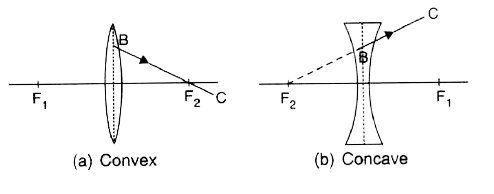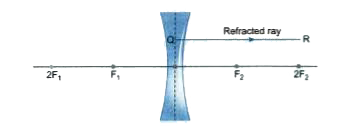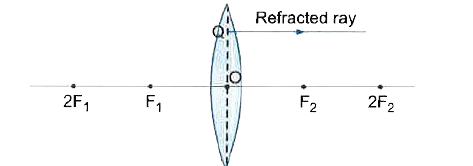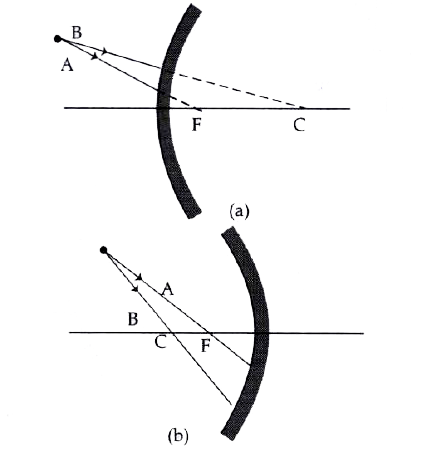Fig (a) and (b) show the refracted ray BC through a convex and concave lens respectively. Complete each diagram by drawing the incident ray if and are the principal foci of the lens.

In Fig. the refracted ray BC passes through the second focus in the convex lens and appears to be coming from in the concave lens, so the incident ray must be parallel to the principal axis. For this, a line BA is drawn from the point B parallel to the principal axis in each case so that AB is the incident ray. The completed diagram is shown in Fig. (a) and (b).

Topper's Solved these Questions
- REFRACTION THROUGH A LENS BOOK - ICSECHAPTER - REFRACTION THROUGH A LENS EXERCISE - EXERCISE-5(A)
12 Videos
- REFRACTION THROUGH A LENS BOOK - ICSECHAPTER - REFRACTION THROUGH A LENS EXERCISE - EXERCISE-5(A) (MULTIPLE CHOICE TYPE)
2 Videos
- REFRACTION OF LIGHT AT PLANE SURFACESBOOK - ICSECHAPTER - REFRACTION OF LIGHT AT PLANE SURFACESEXERCISE - EXERCISE-4(D) MULTIPLE CHOICE TYPE
3 Videos
- REFRACTION THROUGH LENSBOOK - ICSECHAPTER - REFRACTION THROUGH LENSEXERCISE - NUMERICAL BASED MCQ:
10 Videos
Similar Questions
The diagram below shows the refracted ray QR through a concave lens. Complete the diagram by drawing the corresponding incident ray.

View SolutionThe diagram below shown the refracted ray QR through a convex lens.

Complete the diagram by drawing the corresponding incident ray.
View SolutionComplete the following diagrams in Fig. by drawing the reflected ray for the incident rays A and B.

View SolutionA ray of light, after refracting through a concave lens, emerges parallel to the principal axis. Draw a ray diagram to show the incident ray and its corresponding emergent ray.
View SolutionDraw ray diagrams showing the image formation by a concave lens when an object is placed
(a) between focus and twice the focal length of the lens
(b) beyond twice the focal length of the lens
View SolutionDraw a ray diagram to show image formation by a concave lens.
View SolutionDraw ray diagram showing the image formation by a convex lens when an object is placed at the focus of the lens.
View SolutionDraw ray diagram showing the image formation by a concave lens when an object is placed at the focus of the lens.
View SolutionShow the path of a refracted ray formed on refraction through a spherical lens, when (i) incident ray is parallel to the principal axis of lens, (ii) incident ray passes through principal focus (or is directed towards the principal focus) of lens. Draw ray diagrams too.
View SolutionIn the case of a convex lens, show the path of the refraction ray when the incident ray of light (1) is parallel to the principal axis of the lens (2) passes through the focus of the lens (3) passes through the optical centre of the lens.
View Solution
